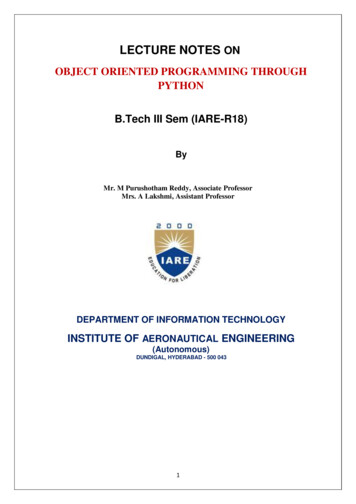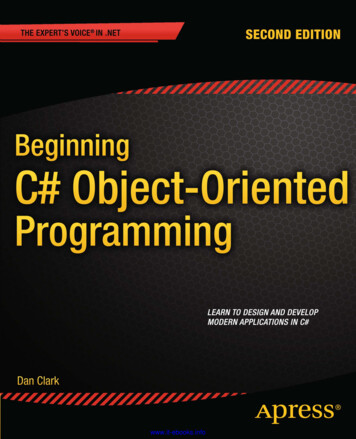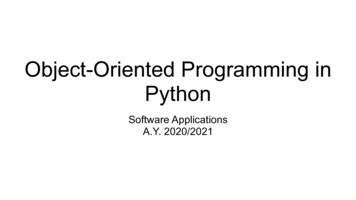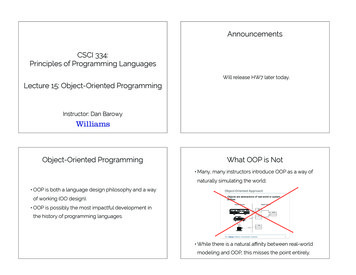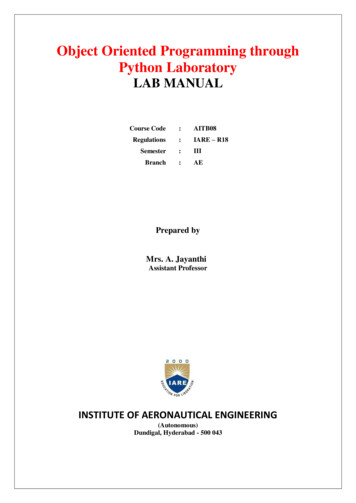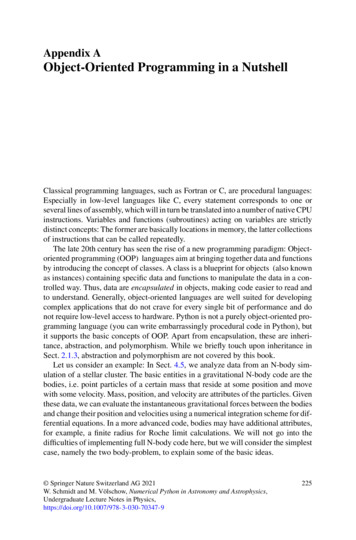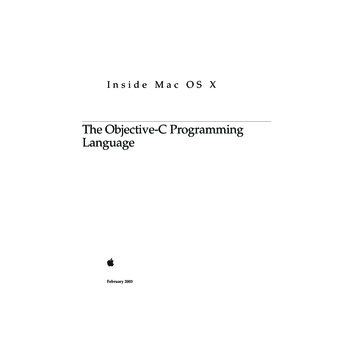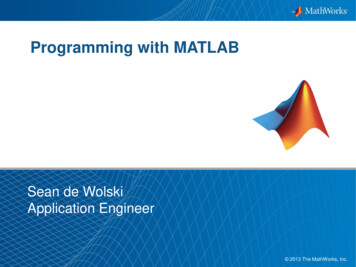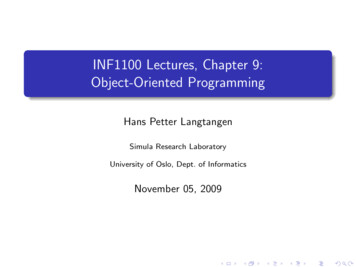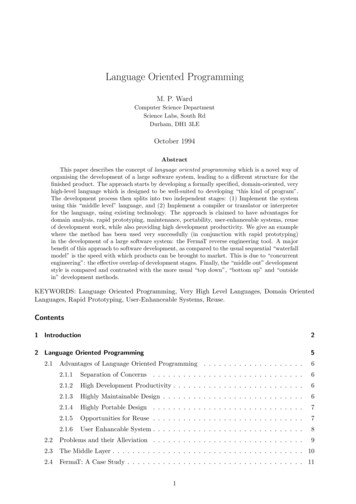
Transcription
Language Oriented ProgrammingM. P. WardComputer Science DepartmentScience Labs, South RdDurham, DH1 3LEOctober 1994AbstractThis paper describes the concept of language oriented programming which is a novel way oforganising the development of a large software system, leading to a different structure for thefinished product. The approach starts by developing a formally specified, domain-oriented, veryhigh-level language which is designed to be well-suited to developing “this kind of program”.The development process then splits into two independent stages: (1) Implement the systemusing this “middle level” language, and (2) Implement a compiler or translator or interpreterfor the language, using existing technology. The approach is claimed to have advantages fordomain analysis, rapid prototyping, maintenance, portability, user-enhanceable systems, reuseof development work, while also providing high development productivity. We give an examplewhere the method has been used very successfully (in conjunction with rapid prototyping)in the development of a large software system: the FermaT reverse engineering tool. A majorbenefit of this approach to software development, as compared to the usual sequential “waterfallmodel” is the speed with which products can be brought to market. This is due to “concurrentengineering”: the effective overlap of development stages. Finally, the “middle out” developmentstyle is compared and contrasted with the more usual “top down”, “bottom up” and “outsidein” development methods.KEYWORDS: Language Oriented Programming, Very High Level Languages, Domain OrientedLanguages, Rapid Prototyping, User-Enhanceable Systems, Reuse.Contents1 Introduction22 Language Oriented Programming52.1Advantages of Language Oriented Programming . . . . . . . . . . . . . . . . . . . .62.1.1Separation of Concerns . . . . . . . . . . . . . . . . . . . . . . . . . . . . . .62.1.2High Development Productivity . . . . . . . . . . . . . . . . . . . . . . . . . .62.1.3Highly Maintainable Design . . . . . . . . . . . . . . . . . . . . . . . . . . . .62.1.4Highly Portable Design . . . . . . . . . . . . . . . . . . . . . . . . . . . . . .72.1.5Opportunities for Reuse . . . . . . . . . . . . . . . . . . . . . . . . . . . . . .72.1.6User Enhancable System . . . . . . . . . . . . . . . . . . . . . . . . . . . . . .82.2Problems and their Alleviation . . . . . . . . . . . . . . . . . . . . . . . . . . . . . .92.3The Middle Layer . . . . . . . . . . . . . . . . . . . . . . . . . . . . . . . . . . . . . . 102.4FermaT: A Case Study . . . . . . . . . . . . . . . . . . . . . . . . . . . . . . . . . . . 111
2.4.12.52.6The FOREACH Construct . . . . . . . . . . . . . . . . . . . . . . . . . . . . 12Examples of a Language Oriented Programming . . . . . . . . . . . . . . . . . . . . 142.5.1Simulation Languages . . . . . . . . . . . . . . . . . . . . . . . . . . . . . . . 142.5.2The QED Word Processor . . . . . . . . . . . . . . . . . . . . . . . . . . . . . 152.5.3The emacs Text Editor2.5.42.5.5The TEX and LATEX Typesetting Programs . . . . . . . . . . . . . . . . . . . 15Perl . . . . . . . . . . . . . . . . . . . . . . . . . . . . . . . . . . . . . . . . . 152.5.6Databases . . . . . . . . . . . . . . . . . . . . . . . . . . . . . . . . . . . . . . 162.5.7Visual Basic for Applications . . . . . . . . . . . . . . . . . . . . . . . . . . . 162.5.8The FermaT Program Transformation System . . . . . . . . . . . . . . . . . . 16. . . . . . . . . . . . . . . . . . . . . . . . . . . . . . 15Other Potential Applications . . . . . . . . . . . . . . . . . . . . . . . . . . . . . . . 162.6.1Spreadsheets . . . . . . . . . . . . . . . . . . . . . . . . . . . . . . . . . . . . 163 Comparison With Other Methods173.1Top Down Development . . . . . . . . . . . . . . . . . . . . . . . . . . . . . . . . . . 173.2Bottom Up Development . . . . . . . . . . . . . . . . . . . . . . . . . . . . . . . . . . 183.3Outside In Development . . . . . . . . . . . . . . . . . . . . . . . . . . . . . . . . . . 183.4Middle Out Development . . . . . . . . . . . . . . . . . . . . . . . . . . . . . . . . . 184 Rapid Prototyping4.119Rapid Prototyping and Language Oriented Programming . . . . . . . . . . . . . . . 195 Conclusion119IntroductionThe problems of designing and developing large-scale software systems are well documented, yetmuch of the research in program development methods has been confined to toy programs andsmall systems. F. P. Brooks in [2] notes the following properties of large software systems whichcause problems as these systems are developed and maintained using traditional methods:Complexity: This is an essential property of all large pieces of software, “essential” in that itcannot be abstracted away from. This leads to several problems: There are often communication difficulties among a large team of developers and thesecan lead to product flaws, cost overruns and schedule delays; It may be difficult or impossible to visualise all the states of the system, and this makesit impossible to understand the system completely. The unvisualised states can lead tosecurity loopholes, or unforseen side-effects when extending or modifying the system; It is difficult to get an overview of the system, so maintaining conceptual integritybecomes increasingly difficult; It is hard to ensure that all loose ends are accounted for; There is a steep learning curve for new personnel.Conformity: Many systems are constrained by the need to conform to complex human institutionsand systems, for example a wages system is greatly complicated by the need to conform tocurrent tax regulations.Change: Any successful system will be subject to change as it is used:2
By being modified to enhance its capabilities, or even apply it beyond the originaldomain; Surviving beyond the normal life of the machine it runs on; Being ported to other machines and environments.Invisibility: With complex mechanical or electronic machines or large buildings the designersand constructors have blueprints and floorplans which provide an accurate overview andgeometric representation of the structure. For complex software systems there is no suchgeometric representation. There are several distinct but interacting graphs of links betweenparts of the system to be considered; including control flow, data flow, dependency, timesequence etc. One way to simplify these, in an attempt to control the complexity, is to cutlinks until the graphs become hierarchical structures [26]. However, even an accurate modelor abstraction of the system may become unreliable as the system is enhanced and modifiedover a period of time.In the mid 1980’s a survey of 19 software development projects by Bill Curtis and his colleagues[8] produced two main findings: There is a thin spread of domain knowledge among software developers in most projects; Customer requirements are extremely volatile.More recently, a survey of 23 software development projects in the narrower area of requirementsdefinition [19] produced these specific findings: Requirements were invented, not elicited. In about two-thirds of the projects, there was apotential market but no customer. The “requirements” were actually preferences which wereprioritised so that the low priority “requirements” could be abandoned if the schedule slipped; Most development is maintenance. System evolution is so common, that a development fromscratch is the exception rather than the rule; Most specification is incremental. The customer is rarely able to provide a complete specification at any stage of the project; Domain knowledge is important; There is a gulf between developer and user. Few developers had adequate knowledge aboutthe user’s work. This led to major misunderstandings about the system’s purpose; User interface requirements continually change.In this paper we describe a novel way of organising the development of a large software system,leading to a different structure for the finished product. We use the term “language orientedprogramming” to describe this approach, since the first stage in this development method is thedesign of a formally specified, domain-oriented, very high level programming language. It shouldbe stressed that one of the aims of the language design is to capture domain knowledge in a form inwhich it can be readily used by the programmers. Our thesis is that a suitable language is a goodway to make domain knowledge available, and the effect of developing in such a language as the firststage in the development process, is to dramatically reduce the development effort required whileincreasing maintainability and enabling reuse. See Figure 1 for a diagrammatic representation ofthe four development methods described in the next four sections.We give some examples of successful system developments, where the final system structureinvolves such a “middle level” language. Even though these systems were not necessarily developedin a “middle out order” (i.e. designing the language first before proceeding with the developmentof the system and implementation of the language), the “language oriented” nature of the systemhas contributed to its success. We also describe one major development project (the FermaT tool)which used an explicit middle out development approach, in conjunction with rapid prototyping,to achieve a highly successful result. Finally, we compare and contrast middle out developmentwith “top down”, “bottom up” and “outside in” development methods.3
Top Down DevelopmentBottom Up DevelopmentTop level structureMore detailed structurehigh level utilitiesLow level utilitiesOutside In DevelopmentMiddle Out DevelopmentTop level structureSystem DevelopmentMore detailed structureDomain-specific languagehigh level utilitiesLanguage ImplementationLow level utilitiesFigure 1: Diagrammatic Representation of Four Development Methods4
2Language Oriented ProgrammingIn the history of computer science, the greatest single gain in software productivity has beenachieved through the development of high-level languages with suitable compilers and interpreters.The use of a high level language often allows a program to be implemented with an order ofmagnitude fewer lines of code than if everything was written in Assembler. In addition, theselines of code will typically be easier to read, analyse, understand and modify. Our experiencewith developing the FermaT program transformation system (see Section 2.4) suggests that there isanother large factor of productivity gain to be achieved by developing a suitable problem orientedvery high level programming language, and using this language to implement the software system.In the case of FermaT, the domain oriented language is METAWSL.In addition to the benefits of smaller code size and increased readability, another benefit ofhigh-level languages is that they encapsulate a great deal of programming knowledge in an easilyusable form. For example, the programmer can let the compiler deal with subroutine call andreturn linking, procedure arguments, simple optimisations, and so on. The second aim of LanguageOriented programming (in addition to the reduction in total code size) is for the domain orientedlanguage to form a repository of domain knowledge in a form which is readily useable by programmers working in that domain. Common objects in the domain will also appear in the language,common operations in the domain will be readily available as language constructs, even thoughthe implementation of these operations may be large and complicated. In the case of FermaT, theforeach, ifmatch and fill constructs in METAWSL enable a programmer to write complex programtransformations in a few lines of code, leaving the system to deal with most of the details and thetricky special cases.This approach (representing domain knowledge in the form of a programming language) shouldbe compared to the IKBS (Intelligent Knowledge-Based System) of representing domain knowledgein the form of a rule-based system. Using a rule-bases system as the repository of domain knowledgegives rise to two problems: (1) The knowledge elicitation problem: transferring knowledge from thebrains of domain experts into a collection of rules suitable for implementing in a rule-based system; and (2) Enabling programmers to extract and make use of the information in the repository.Much work has been done on the first problem, with some notable successes in the area of medicaldiagnosis and hardware and software fault diagnosis. These are areas where the human knowledgeis readily expressable in the form of interacting rules, and where the software system under development makes direct use of the rule base to achieve its functions. In other areas, for example thedevelopment of transformation systems, it is difficult to see how the programmers could make use ofa rule-based representation of domain knowledge, while a very high-level domain-specific languagecan certainly be used, and re-used, in large software development projects in that domain.The first stage in a language oriented development is therefore a language design, providing aformal syntax and semantics for this language. A language consists of a set of primitive operationstogether with language constructs and specialised abstract data types.Having completed the language design, the development of the system breaks down into twolargely independent stages (which can be carried out in any order, or even in parallel):1. Implement the software system in the new language;2. Implement the language in some existing computer language, i.e. write a compiler or interpreter or translator for the language.Either or both of these stages may benefit from a recursive application of the method. Such arecursive development will result in a series of “language layers” with lower-level languages at thebottom, and very high-level domain-specific languages at the top. Each level is implemented interms of the next lower level by a process of interpretation, compilation or translation (which maybe a formal semantic-preserving transformation). Each interpretation, translation or compilationstage may involve optimisation at both the “source” and “target” language levels.5
It is essential that all of the middle level languages should be formally specified; since it isthe availability of a formal specification which allows the system development and language implementation to be carried out independently. It is also important that the languages should beconceptually simple, easy to parse (by humans and computers) and should benefit from the latestdevelopments in programming language design and implementation.2.12.1.1Advantages of Language Oriented ProgrammingSeparation of ConcernsThe method provides a complete separation of concerns between design issues, which are addressesin a domain specific language, and implementation issues, which are addressed in the implementation of the language, and are separated from the design of the system. In addition, by making use ofrecent research in programming language design and implementation, it should be possible to keepthe language design simple yet powerful and expressive. This will greatly reduce the complexity ofthe system implementation.2.1.2High Development ProductivityOur experience with FermaT, and the experiences from other projects, indicate that a systemimplemented using the language oriented method, as a series of language levels, ends up muchsmaller than an bottom up or top down implementation of the same system. This is due to the factthat with a problem-specific very high level language, a few lines of code are sufficient to implementhighly complex functions. The implementation of the language is also kept small since only thosefeatures which are relevant to the particular problem domain need to be implemented.The small size of the final system means that the total amount of development work required isreduced, without increasing the complexity of the system, and for the same or higher functionality.This leads to improved maintainability, fewer bugs, and improved adaptability.The very high level language means that a small amount of code in this language can achieve agreat deal of work. This has already been noted for general purpose high-level languages, where anorder of magnitude increase in productivity has been recorded. So called “4GLs” (forth generationlanguages) were an attempt to achieve a similar increase in productivity by the development ofgeneral-purpose very high-level languages. These were less successful than anticipated, partly dueto a lack of formal specification of syntax and semantics, and partly because they tried to begeneral purpose languages. One large financial organisation is currently planning to abandon the4GL altogether, and attempt to maintain the 40 million lines of machine-generated COBOL instead!Our experience shows that by restricting the language to a specialised domain, the hoped-forgains in productivity can be achieved.2.1.3Highly Maintainable DesignStudies have shown that the most important factor affecting maintainability is the size of thesoftware system: more lines of code will generally require more maintenance effort [17,30]. Thesmall total size of a system produced by the language oriented approach will implies that it will betherefore be highly maintainable. In addition, major functions of the system are implemented asa few lines of code in an appropriate language: this means that bug fixing and enhancements areeasy, and there is a reduced chance of an unexpected interaction with other parts of the system.With traditional programming methods, many design decisions (such as the representation ofa data object, the file structure, the algorithms used to implement high-level operations etc.) are“spread out” through the code. It becomes very difficult for maintainers to determine all theimpacts of a particular design decision, or conversely, to determine which design decisions led tothis particular piece of code being written in this way. With language oriented development, theeffects of a design decision will usually be localised to one part of the system. For example, the6
decision to use a particular algorithm will be localised to one procedure: the algorithm will bewritten in an appropriate language and will therefore be short and easy to understand. Similarly,the decision to implement or represent a data structure in a particular way would normally haverepercussions throughout the code, while in this case the effects would be localised to one partof the interpreter or translator. Advocates of “modular design” make these same arguments andsuggest that the solution is to localise each design decision to a single module [26]. But the morefundamental design decisions cannot always be captured in a module.2.1.4Highly Portable DesignPorting to a new operating system or programming language becomes greatly simplified: only themiddle language needs to be re-implemented on the new machine, the implementation of the system(written in that language) can then be copied across without change. This is especially the casewhere a hierarchy of language levels has been developed, starting with a middle level language,implementing it in terms of lower-level language(s), and using it as the basis for implementinghigher-level, more domain and problem-specific language(s). In this case only the lowest levellanguage will need to be ported to a different machine or operating system, and this will be asimple task. This is one reason for the high portability of the TEX program: once the WEB-toPASCAL or WEB-to-C programs have been ported, the one megabyte tex.web source file can becopied across and compiled without change.In the case of the FermaT tool, the lowest level translator and support library consists of 2–3,000 lines of LISP code. This translates from low-level METAWSL to LISP, all the rest of thesystem is written in METAWSL. To port the system to a new version of LISP, or even to a new baselanguage such as C, only requires rewriting the lowest level translator: and this is a comparativelysmall task–in fact, the first version of the translator was written in less than three man days. TheFermaT system is currently being ported from a Unix environment to a PC environment, using Crather than LISP as the implementation language.The DataFlex database language has also been ported to many machines and operating systems,again this is possible because much of the DataFlex system is written in DataFlex which is a macrolanguage built on a small core of primitive database functions and user interaction functions.The advantage of portability is not exclusive to language-oriented programming, a similar advantage (for similar reasons) can be claimed for bottom-up development, and for developmentsusing tools such as class libraries. However, it could be argued that a class library is in fact anexample of a domain-specific language (albeit with a highly restricted syntax).2.1.5Opportunities for ReuseThere is a great potential for re-use of the middle level languages for similar development projects.The languages encapsulate a great deal of “domain knowledge”: including knowledge of which datatypes, operations and execution methods are important in this domain, and what are the best waysto implement them. This kind of knowledge is extremely useful for requirements elicitation fornew systems [19], new system development [8] and program comprehension of the existing system[3]. Hence there will be good opportunities for reuse within the project and beyond, includingreuse of the language for other similar projects. A well-designed language is generally much morereusable than a collection of functions, abstract data types or objects: to understand this fact,imagine writing a typical C program in Assembler, where the C compiler has been replaced by alarge library of Assembler routines! One of the main advantages of a well-designed domain-specificlanguage is the new programming constructs which can be combined, more-or-less orthogonally invarious ways. In the case of perl, the language provides a convenient notation for regular expressionsearches and associative array handling, while the programmer is freed from worrying about memoryallocation and freeing. The foreach construct in METAWSL captures the intricate details of whichcomponents of a statement are “terminal statements”, in such a way that the programmer can7
write programs which manipulate “terminal statements” without needing to know how preciselyhow to calculate them.One area in which these opportunities for reuse are particularly valuable is that of sectorspecific companies serving niche markets. These companies produce a range of software withina specific domain; with their competitive advantage coming from specialised knowledge of thedomain, a speedy response to new product opportunities and a rapid turnaround of users’ requestsfor enhancements.A project which has recognised the value of capturing domain knowledge in the form of alanguage is the Draco project [10,25]. This aims to encourage the reuse of design information infuture program development projects by the use of domain languages together with the recordedresults of a domain analysis. The system under development is written in a number of differentdomain languages, these programs are refined into the languages of other domains, and ultimatelyinto executable code. In contrast to the Draco approach, our approach uses a single domain forseveral related development projects, rather than several small domains for each project. Ourcontention is that the best representation of domain knowledge (for programming purposes) isthe design and implementation of a domain-specific programming language. Since our domainlanguages are implemented programming languages, there is no need for refinement to an existingprogramming language.2.1.6User Enhancable SystemA system built using a hierarchy of language levels will have a “top level” language which is highlydomain-specific, very high level, and formally specified. This language will almost certainly beinterpreted rather than compiled: a few lines of code in this language is sufficient to implementeach of the operations of the software system, so the interpretation overhead is negligible. With asuitable interface, the user could be provided with a high degree of control over the functionality ofthe system: calling up and editing the code for specific functions and using the top level languageas a powerful “macro language” which has access to every function of the system. Note that theimplemented functions would be written in this language, and would therefore provide “templates”for the user to modify and enhance—to provide their own functions or extend the existing ones. Atthe lowest level, this provides a macro language for the user. A major problem with most “macro”and “query” languages is that they are horrible languages (according to Hoare’s “Basic principles oflanguage design”, see Section 2.3). They are not formally specified, were not designed from scratchto be a full programming language, and usually were not designed by people trained in languagedesign, or familiar with other languages. Another problem is that it is rare to find that all ofthe systems functions are available via the macro language. In contrast, the language provided bythe language oriented development is actually used to implement the whole system: it will be awell-designed, fully tested language, and all the systems facilities are guaranteed to be available inthe language. Customisation of the system will be trivial.It is easy to give the user the power to enhance the system in various ways, writing their ownfunctions in the top level language, or modifying the ones provided (cf QED, FermaT, emacs, seeSection 2.5). The user can be given access to the source code for the whole system: this will be a“small” program or collection of small programs in a highly domain specific language. In the caseof QED, the “source code” is about 3000 lines of interpreted q code to which I have added about650 lines of code to implement my personal functions. The sparc executable for the interpreter ofthis very high-level language is nearly one megabyte of code!The FermaT transformation system includes around one hundred transformations, each implemented in METAWSL, and ranging in size from a few lines to a few pages of code. The userscan construct their own transformations by composing existing transformations (such transformations are automatically guaranteed to be correct), or by writing new METAWSL procedures. SinceFermaT is itself a program manipulation system, it is possible in this case to use the system to8
maintain and enhance its own source code.The LATEX typesetting system is written as a collection of TEX macros. The user is able toextend the system by writing their own macros or (more commonly) using “style files” of macroswritten by other people. In addition, knowledgeable users can modify the standard style files toachieve their own effects.One danger with giving users full access to the source code of a system is that their “enhancements” may actually degrade or damage the system over a period of time. If serious damage hasbeen caused, the user can always go back to a previous working version. More importantly though,even after many enhancements the total size of the system will still be small, so if a completeredevelopment (or reverse-engineering) of the system turns out to be necessary, this will be a fairlysmall task.The highest level language can be made “safe” in the sense that any code written by the userwill do something meaningful in terms of the problem domain (rather than crashing the systemwith an unhelpful error code! See Section 2.3). This is a reasonable requirement because the toplevel language is restricted to a small problem domain and uses concepts and operations in thatdomain. For example, the q code interpreter used in QED will, by default, terminate any loopwhich executes more than 1,000 iterations. This is ample for the vast majority of operations, andthe limit can be raised or removed if necessary. The result is that the user cannot hang up theeditor by inadvertantly writing an endless loop. In the FermaT system, the user is able to constructnew program transformations (meta-programs) by combining existing transformations, tests andso on. Provided all the editing operations invoked by the meta-program are carried out by existingtransformations, the meta-program will itself be a valid transformation.2.2Problems and their AlleviationThe main problem with introducing this development method is that good language design is hard.It is a highly skilled task, requiring a good grasp of the problem domain, the system requirements,and the available options in terms of computer science technology. However, the benefits from agood design are enormous, and there are ways to alleviate the problems (see below).It should be emphasised that the aim is not to “de-skill” the programming task, but rather theopposite: to enhance the abilities of a skilled designer and domain expert. The aim is to capturea useful body of domain knowledge in the form of a domain-specific language which can be usedby a skilled programmer to develop a powerful and useable system in a highly productive manner.With a user-enhancable system, the skill level required of the “knowledgeable user” is then reduced,since the implementation language uses familiar domain concepts, and the implementation itselfprovides “templates” which show how to use the language to achieve various results.A potential problem is that writing in a very high-level language can “distance” the programmerfrom certain efficiency constraints: the programmer needs to understand the efficiency implicationsof various constructs in the language.There may be management iss
very high level programming language, and using this language to implement the software system. In the case of FermaT, the domain oriented language is METAWSL. In addition to the benefits of smaller code size and increased readability, another benefit of high-level languages is that they encapsulate a great deal of programming knowledge in an .
